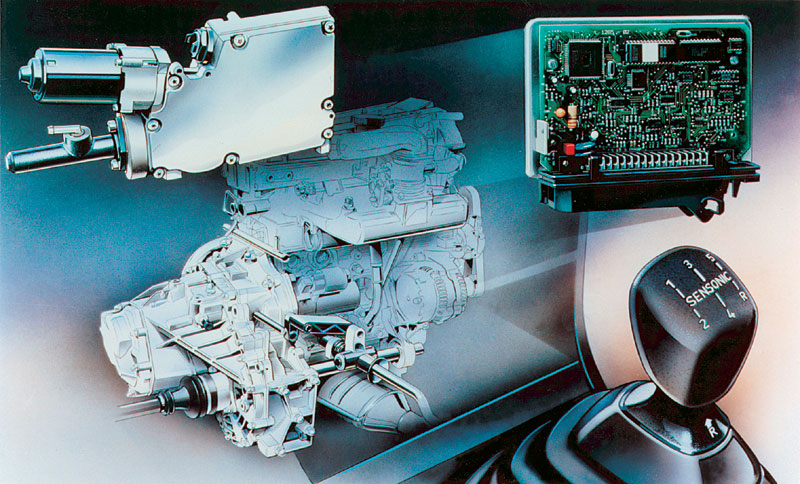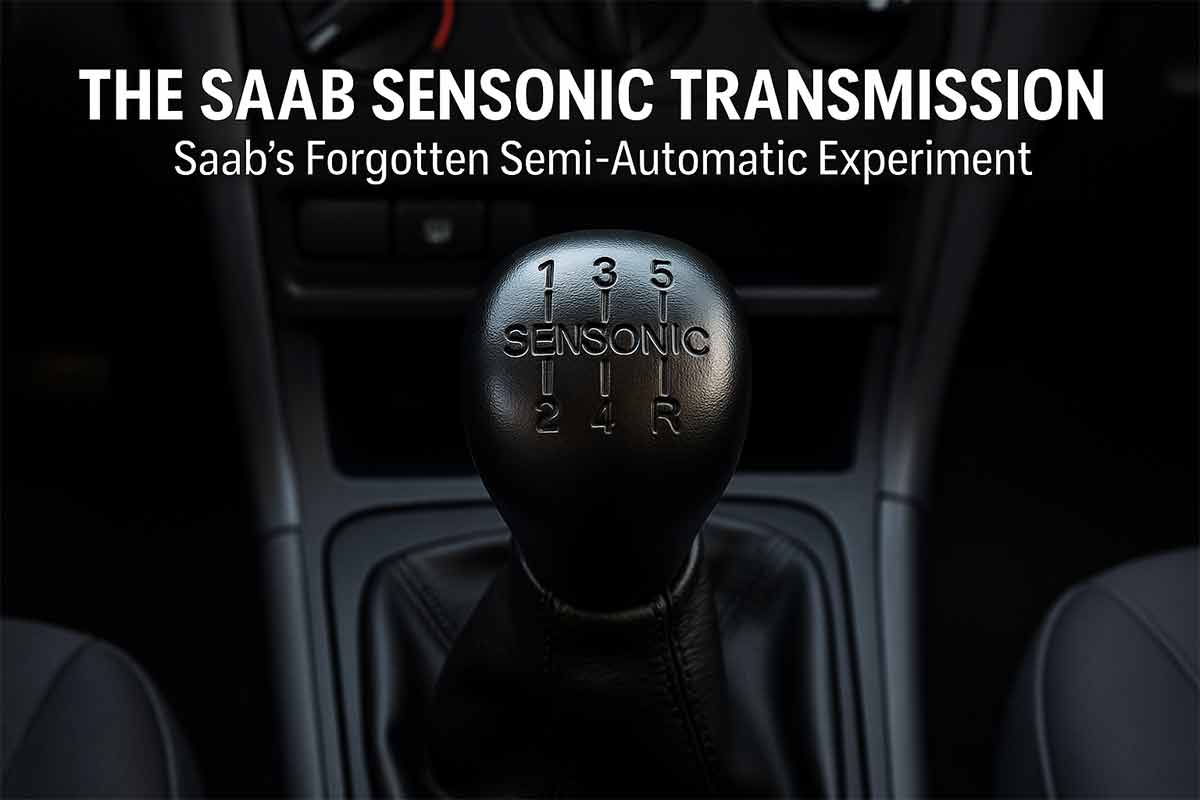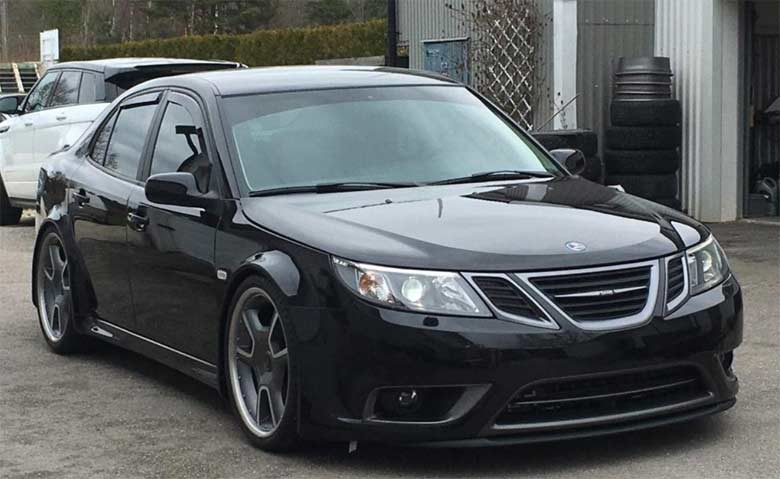Saab’s Mid-90s Leap into Clutchless Technology
By the mid-1990s, Saab’s reputation for doing things differently was already well established. From the introduction of turbocharging in everyday cars to the industry’s first active head restraint system, the brand had never been afraid to experiment. But the Sensonic transmission — offered only on turbocharged Saab 900 NG models — was a risk of a different kind.
Sensonic looked like any other five-speed manual setup at first glance. The familiar H-pattern gear lever was there, but something important was missing: the clutch pedal. In its place, Saab engineers installed a suite of electronics that could control the clutch faster and more precisely than any human driver. This wasn’t an automatic, and it wasn’t a conventional manual — it was a hybrid concept in the purest Saab sense.

Understanding the Saab Sensonic
The Saab 900 Sensonic is often described as a car without a clutch, which is not entirely accurate. The clutch pedal is absent, but the car automatically operates the clutch as soon as the gear lever is moved. The concept aimed to combine the best of both worlds: the pleasure of driving a manual transmission without the constant clutch engagement required in traffic.
How the System Worked
The moment the driver began to move the gear lever, a computer-controlled microprocessor sprang into action. This microprocessor drove an electric motor, which in turn operated a hydraulic actuator connected directly to the clutch master cylinder. Using hydraulic fluid, the actuator disengaged the clutch, allowing the driver to shift into the next gear without ever pressing a pedal. As soon as the gear change was complete and the hand released the lever, the clutch re-engaged instantly.

At a standstill, with the car in gear, the system only released the clutch when the throttle was applied. If the driver let go of both pedals — brake and accelerator — the Sensonic system issued an audible warning and flashed a message on the on-board display. If there was still no action after seven seconds, the system would shut down the engine entirely, preventing stalling or unintentional rolling.
Interestingly, Saab’s owner’s manual for Sensonic-equipped cars referenced a “Hill Start” function — designed to help prevent rolling forwards or backwards when starting on an incline. However, this feature never made it into production. It remained a printed promise, not a mechanical reality.
Driving Experience: Between Engagement and Automation
When it worked as intended, Sensonic was a joy. Gear changes were immediate, with the clutch engagement faster than even the most skilled human driver could achieve. In fast, flowing driving, it gave a sense of seamless control, freeing the driver’s left foot entirely.
Yet in slow maneuvers — parking on a steep incline, for example — the absence of a clutch pedal sometimes made control less precise. Saab test drivers admitted that rolling starts on hills could be tricky, especially since the Hill Start function was never implemented. This gap between design intent and production reality became one of Sensonic’s subtle weaknesses.
Reliability and Maintenance
The technology behind Sensonic was cutting-edge for the era, but complexity was its Achilles’ heel. The entire system – from sensors on the gear lever, to the electric motor, to the hydraulic actuator, to the microprocessor – had to operate perfectly in unison. Any fault in the chain could leave the car immobile.
Some owners enjoyed years of trouble-free use, praising the system for its smoothness and novelty. Others faced repeated failures, especially involving the actuator and sensors, often leading to costly repairs. Over time, the rarity of replacement parts made keeping Sensonic functional a challenge. Many owners opted to convert their cars back to standard manual operation.
Availability and Pricing
Currently, there are two Saab 900 models equipped with the Sensonic transmission available for sale in the Netherlands. Surprisingly, they are quite affordable options. The first one has covered 291,000 kilometers and is priced at 3,950 euros. The second Saab 900, a Talladega edition with 185 horsepower, has 213,000 kilometers on the odometer and carries a price tag of 6,750 euros.
Adapting to the Sensonic Experience
According to Saab Specials, the seller of these vehicles, driving a Saab with Sensonic requires some getting used to. It is recommended to consider this car as a unique addition to your collection. The Sensonic transmission represents an interesting chapter in the rich history of the now-defunct Saab brand and would pair well with a Saab 9-5ng Sportcombi or a Saab 9-2X.
Saab Sensonic and Mixed Reception
In an episode of Top Gear titled “The Worst Car In the History Of The World,” the Sensonic transmission was featured, and it garnered mixed reviews. The main issue, as expected, revolves around the absence of a clutch pedal. Maneuvering during parking becomes challenging since there is a slight delay between releasing the brake and the engagement of the clutch. This delay becomes particularly noticeable when attempting to park on an incline.
See video by Top Gear below:
Why Sensonic Disappeared
The end came quietly in 1998. Saab was transitioning away from the 900 NG, and Sensonic had never achieved broad market appeal. Its target audience — drivers who wanted both manual control and convenience — proved too small. Coupled with maintenance costs, part scarcity, and the absence of a clear performance advantage over traditional manuals or well-tuned automatics, Sensonic faded into obscurity.
Multiple Versions of Sensonic
The company Fichtel & Sachs introduced a similar transmission called the Saxomat in the 1950s. It was available in various cars, including the Saab 93, Fiat 1800, Lancia Flaminia, and Opel Rekord. However, this technology never gained significant popularity. Although the Saab 900 experienced a brief resurgence of the Sensonic system in the 1990s, it has become exceedingly rare in modern vehicles.

A Comparison to Quickshifters
In the realm of motorcycles, there is a similar concept known as a quickshifter. With a quickshifter, it is possible to shift gears without using the clutch. However, the mechanism differs slightly: the quickshifter interrupts the ignition momentarily, relieving the drivetrain to enable smooth gear changes. It is worth noting that theoretically, it is possible to shift without the clutch in any manual transmission car, but this should be done at one’s own risk.
Unique and quirky innovation
The Saab Sensonic transmission represents a unique and quirky innovation in the world of manual transmissions. While it lacks a clutch pedal, the system automatically operates the clutch when the gear lever is moved. Although it received mixed reviews due to its peculiarities, the Saab Sensonic remains an interesting and affordable choice for collectors or those seeking a distinctive driving experience.
Sensonic’s Legacy
Despite its short life, Sensonic remains a fascinating footnote in Saab history. It embodied the brand’s ethos of innovation, even if it never became mainstream. In hindsight, it foreshadowed later automated manual systems — from Ferrari’s F1 paddles to Volkswagen’s DSG — proving Saab was again ahead of its time, albeit with fewer resources to refine the technology.
For collectors today, a Sensonic-equipped Saab is a rare prize. Functioning cars are scarce, and while the novelty factor is high, so is the caution: repairs require patience, ingenuity, and often a willingness to fabricate or adapt parts.
People Also Ask — Answered
How does the Saab Sensonic transmission work?
Sensonic used sensors on the gear lever to trigger a microprocessor, which drove an electric motor that operated a hydraulic actuator connected to the clutch master cylinder. This allowed fully manual gear selection without a clutch pedal, with clutch engagement and disengagement handled electronically.
Was the Sensonic system reliable?
It varied. Some owners reported years of trouble-free driving, while others struggled with actuator failures, sensor issues, and electronic glitches. The system’s complexity and part scarcity made long-term ownership challenging.
Why did Saab discontinue Sensonic?
Low market demand, high maintenance costs, and the end of the 900 NG model all contributed. Without enough buyers and with no successor platform ready, Saab quietly ended production.
What years was Sensonic available on Saab?
Mid-1990s through 1998, exclusively on turbocharged Saab 900 NG models.
Saab Sensonic problems — From actuator failures to electronic control unit faults, common issues made the system a gamble for long-term use.
Sensonic clutchless manual conversion — Many owners replaced Sensonic with a standard manual gearbox to improve reliability.
Saab 900 NG Sensonic for sale — These cars are rare and usually surface only in specialist enthusiast markets.
Historical Saab transmission innovations — From freewheel systems in the 1960s to Sensonic in the 1990s, Saab consistently explored unconventional drivetrains.












A disaster especially if you have active driving style and tune your car.
Used to own that kinda car from 1999 – 2018.
Had constant issues with it.
After the car was tuned to stage 3 it would’ve needed stiffer clutch. If you would’ve replaced the original clutch with the clutch of Viggen the system would’ve not worked.
Saab sold a conversion kit with the clutch pedal (I think I still have the installation instructions somewhere). So after suffering lots of issues the car was converted to manual.
Wouldn’t recommend it to anyone. The only cool thing was that it allowed to shift gears with 20% throttle.
I own a Saab 900 with Sensonic since more than 20 years and have driven more than 100.000 km with. I have always been very satisfied with it, never had problems even when towing a 1.500 kg caravan in the mountains. Of course it has peculiarities and you to understand and respect the limitations, but then it works really fine. I still like it very much.
I loved my 1997 900SE Turbo Sensonic
Drove it whilst selling SAABs. Was a bit weird
A failure by any measure
Love mine, had it 10 years, yes it has its idiosyncrasies, but then don’t most cars, but when used to it not a problem. In fact my local garage loves it, he always asks if he can take it for a test drive after the service.
To Rikard Nilsson
did you work for saab?
To Ron Vandeweerdt
No but friends of mine did. Their problem always was the tech nerds came up with too expensive solutions for relatively simple things. Like the super complicated ignition system, using 80 volts across the spark plugs just to measure the results of the last combustion. The info was used as feedback to tweak fuel mixture/ignition point for the next combustion. Didn’t really make the car more fuel efficient in the end, just one of many things making Saab loose money on every sold car.
To Rikard Nilsson
it was called ionization. I worked for saab for 25 years and I see it differently thanks.. good day.
To Ron Vandeweerdt
Well, thats the problem. Techs ran the company, with lack of understanding basic economy. Had they managed to make money, Saab would likely be around today.
I think SAAB’s worst thing ever made
James May trying to parallel park a Saab with this gearbox was fucking hilarious 😂😂😂 dat boi is a legend 😂
Mine worked fine for the first 5 years, reversing down hill was unpredictable and in later years you had to make sure the hand brake was on at road junctions as the car would take off on tick-over some times. Mine eventually gave up when a fluid seal failed and ruined the electronics.
There’s one still for sale at Scherpenisse (Oud Beijerland); a red Talladega. (€3950)
I was interested but decided to buy a nice 2004 9-3 turbo aut. instead.
Volkswagen made something like this from 1970-1979 called an Automatic Stick Shift. The VW design used a torque converter that eliminated the clutch entirely and only shifted out of gear when shifted into Neutral. I suppose the advent of the real VW automatic transmission and the demise of the classic Beetle led to the end of the Automatic Stick Shift. The VW design did seem to have advantages over the Saab design.
Renault also had something similar on a Twingo…